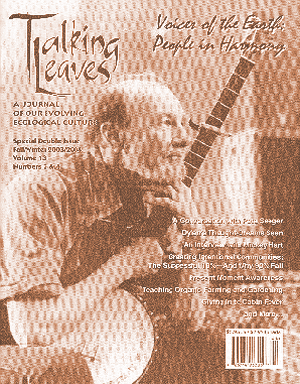Dear Friends of Lost Valley,
We'll make this short and sweet:

Dear Friends of Lost Valley,
We'll make this short and sweet:

If I had believed the majority of critics, I never would have ventured to the theater to see Bob Dylan's new movie, Masked and Anonymous. I am glad I did not listen to the critics. Unfortunately, most moviegoers and theater owners did. The movie played in Eugene a scarce week (during which I saw the movie twice); other runs, where they even occurred, were similarly abbreviated.

As always, this year has been an eventful one here at Lost Valley Educational Center. Among the highlights of 2003:

Regular readers may have noticed that there was no Fall 2003 issue of Talking Leaves. This gap occurred mainly because the editor's (my) other, garden-program-coordination hat this summer became too large (see "Gardening Words on a Rainy Afternoon"), which meant my Talking Leaves hat had to become very small to compensate. (Both hats have now resumed reasonable dimensions, and, having learned from the experience, I am now sworn and equipped to keep them that way.)
As a side benefit, waiting to produce this special double issue, once time made itself available for the work, has resulted in a considerable savings in total printing and shipping costs, as well as what we hope to be a higher quality, more well-rounded magazine.

The new training manual from the Center for Agroecology and Sustain- able Food Systems, Teaching Organic Gardening and Farming, is a major, probably unparalleled resource for teaching sustainable agricultural skills and concepts to students. It represents a milestone in the development of instructional materials in this area, and will stimulate anyone who has worked in this field to reflect on our own lessons taught and learned.
Over the past 35 years, the UC Santa Cruz Farm and Garden Apprenticeship has trained over a thousand apprentices, including many of the farmers and gardeners I know (and including me, in 1986), in an intensive six-month residential program which combines classroom instruction, small group field classes, hands-on training, and student-directed reading and projects. Drawing on this wealth of practical instructional experience, and following closely the curriculum of the Apprenticeship, the 600+ photocopyable, three-hole-punched pages in this manual amass a rather incredible amount of information, teaching tools, and resources, organized into sensibly sequenced, manageable units.